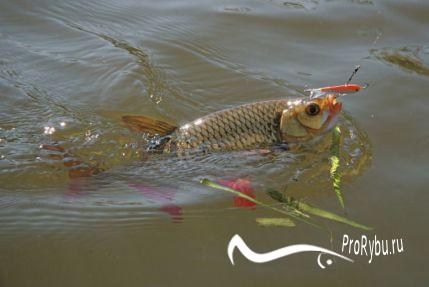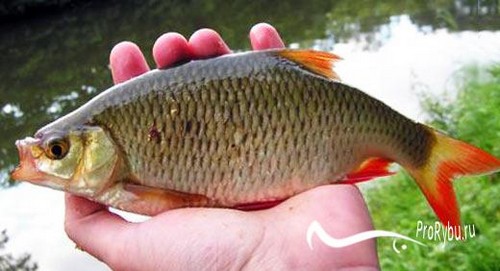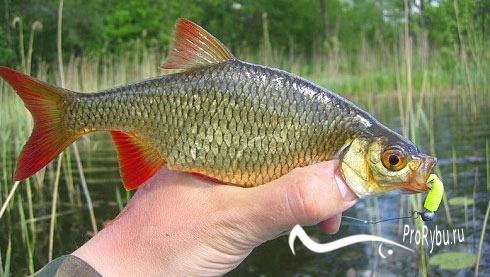Common Rudd – Scardinius cerythrophthalmus. It belongs to the family Cyprinidae.
Rudd has thick, high and wide body. From the ventral to the anal fin is covered with scales keel.
The back of the fish is brown mixed with green, the sides Golden. In large specimens there is a characteristic intense reddish coloration.
Description redfin
Scales from fish of large, tightly seated. The edges of the scales have a brown rim.
The fins are reddish staining of different intensity. Back fin has a black base, the chest is grayish. Back fin has 3 not branched and 8-10 branched rays, anal 3 /10-13 respectively.
Small head with turned-up mouth. The edge of the lips redfin has a yellow border. Pharyngeal teeth of Rudd-serrated, laterally compressed. Their tops are bent into a kind of hooks.



In 37-45 lateral line scales.
The Rudd is widely distributed in waters of Europe to the Urals and Central Asia.
Despite all the beauty of this fish, it is classified as slow-growing and low-value.
Habits redfin
Rudd, like any other fish, has a peculiar character. Nature has generously endowed by her beauty, can hence its desire to show off, swim on the surface and causing envious glances and sighs of the fishermen. They say: “Look at me! Who can compare with me?!”
Fish do prefer to keep the middle and upper water layers.
And places for their habitat, Rudd chooses special. Vegetation – mandatory attribute. Reeds, pond lilies, reeds, arrowhead and other aquatic plants are home to this fashionista. They provide protection from predators, provide shade and food.
You should know that near the coast, in thickets of vegetation inhabited by the juvenile fish. It usually keeps in flocks and spends here all the time. Large individuals choose to dwell in remote from the coast places. This is usually underwater hills with the presence of vegetation. To the shore the large Rudd comes only to search for food.
But underwater vegetation suitable for fish only in the period of flowering and growth. At the end of summer starts to happen decline and decay of these plants and the fish goes into the reeds and cane.
Rudd leads exclusively diurnal, and at night goes into the grass and warm the lower layers and holds the dark, motionless, resting.
In addition, Rudd studiously avoids fast currents. The fish prefers quiet water of lakes and sections of rivers with a quiet current. Bottom prefers a soft, moderately silty. Such is the quiet and Bohemian life.
Rudd eats only in the warm time of the year. In our latitudes, is from may to September.
After cooling, the juvenile leaves in the winter in the cane. Large specimens are deposited in the pit in the depths.
Rudd, because of its simplicity and ability to tolerate considerable oxygen deficit in water, able to endure the toughest of winters.
Food rudds
Despite the fact that Rudd are often found with a roach and some other species, there are significant differences as to the habitats and food. Therefore, competition in these species is small.
After the transition to independent feeding, the young fish begins to consume zooplankton. Basically it is small cladocerans and rotifers. However, due to the rather high rate of growth and structure of the oral apparatus, Rudd moves quickly to food of large zooplankton crustaceans. Your food fry finds in the undergrowth vegetation of the coastal zone.
The main part of the diet of adult redfin are the young shoots of aquatic plants, filamentous algae (Cladophora, Spirogyra).
Not away the fish and eat the insects caught in the water. This method of power redfin, facilitates the structure of the oral apparatus – her mouth is large and directed upwards. On this property is based a few ways of catching fish. With them we will look at next.
The conformation of the mouth also allows Rudd to consume the eggs of molluscs on a leaf underside of pods (water lilies). You can clearly hear the characteristic cocanie.
Rudd may also eat the eggs of amphibians and other species of fish, various worms and larvae.
Major Rudd can prey on juvenile fish, showing the predatory habits. Especially strongly these feeding habits begin to appear in autumn, before leaving the fish for the winter. The number of food organisms at this time is sharply reduced, and fish need to fatten the supply of nutrients. That accounts for the Rudd becomes a robber.
Reproduction redfin
The Rudd spawns quite late, together with tench and carp, when the temperature of water more than 16S. In our latitudes this time is in may – June.
All Rudd at that time gets more vivid coloration, and the head and back of males, appear characteristic warts. However, scales are not receiving characteristic, such as a roach, strong roughness.
Rudd becomes sexually Mature when reaching 10-12 cm In the conditions of Belarus is age 3-4 years.
Spawning of this fish is portioned and implemented in 2-3 hours.
Spawning fish takes place in the morning and daytime. To determine where reproduction is possible only by swinging the reed and reed stems. The fish are not jumping out of the water and the process of spawning is pretty quiet, because spawning occurs on the bottom.
In addition, it should be noted that to spawning fish fits in small flocks and do not form significant accumulations.
Rudd actively fed during breeding and if You were to spawn, then return home with a rich catch.
Caviar fish small, with a diameter of about 1 mm, different color portions. Mature eggs, the first portion, has a bright yellow color, the subsequent portion is pale yellow in color, and the last one whitish.
Deposited eggs on roots of plants and find it quite difficult.
Fertility redfin great. With a length of about 13 cm absolute fecundity is more than 10 thousand eggs, with a length of more than 20 cm – more than 125 thousand eggs.
The relative fecundity of fish is 220 – 400 eggs per 1 g of body weight.
Despite the large number postpone eggs, survival of juveniles is negligible. This is due to the loss during incubation and during larval development, and the fact that a significant part of the eggs not fertilized at all.


